If you do any cooking at all, you’ve run across a recipe or two that calls for chicken broth. Instead of relying on expensive canned or boxed broth, make your own chicken stock at home for a budget friendly alternative.
Originally published June 2011; this post has been updated.
What’s the Difference Between Stock and Broth?
You’ll often see the terms used interchangeably, and I do so here, as well. Stock and broth are pretty similar in their flavor and how you’d use them in the kitchen. The difference is in how they are made.
Chicken stock is made with just the bones. Using the carcass of a roasted chicken to transform it into a golden stock is perhaps the most frugal thing you can do in your kitchen.
Chicken broth is made from meat, or meat with bones. In other words, a whole chicken (or chicken parts) are cooked to create a broth. When making broth, you’ll end up with cooked chicken that can be removed from the bone and used in recipes or stirred back into the broth to make a chicken soup.
The methods included below work interchangeably with either a whole roasted chicken or the bones remaining from a roasted chicken meal. You can also use this method to turn a leftover turkey carcass into a rich turkey stock.
5 Easy Steps to Transform Your Pantry!
Ready to switch from store bought to homemade? Let me help you make some changes! Grab my FREE five-part guide to getting started.
Why Make Chicken Stock at Home?
My mother would no sooner toss out a leftover roasted chicken carcass than she would rob a bank. Consequently, neither would I. But I’m shocked at the number of roast chicken carcasses I’ve seen go in the trash over the years (mind you, I’ve rescued some, too). Is it because people don’t know how to make chicken stock? Or because they think it is too much work?
Making chicken stock is like finding free food. Because you’re using the bones, essentially a waste product from another meal, it costs next to nothing. This is typically what I make, rather than using a whole chicken, purely due to the frugality of it.
Homemade chicken stock/broth eliminates the cans or boxes that store-bought stock comes in, too.
Ingredients
Chicken — You’ll need to decide if you want to make this recipe with the chicken carcass or a combination of bones and meat. If you use just the chicken bones, use two to three carcasses for better flavor. You can use a whole roasted chicken – yes, even store bought rotisserie chicken – or purchase inexpensive chicken parts like legs and wings.
Vegetables — Technically, these are optional. You can easily make a very plain chicken broth or chicken stock recipe without them. But adding veggies adds more flavor. In the recipe below I offer some very specific amounts, but know that this is flexible. Use fresh veggies, wilted veggies salvaged from your produce drawer, or use the trimmed ends of carrots, celery, and onions that you cut off when you’re cooking. (Toss them into a container and stockpile them in the freezer. When you’re ready to make a batch of homemade chicken stock, add those for extra flavor.)
Seasonings — Again, these are optional but can elevate the flavor of your broth. If you plan to use the stock in a variety of recipes, keep it simple. I tend to add bay leaves and a few sprigs of thyme along with salt and pepper. Parsley is another herb that works well for a simple stock.
Vinegar — Increasing the acidity of the broth by adding a bit of vinegar can help draw more nutrients out of the bones.
The Handcrafted Pantry

Ready to DIY your pantry with more wholesome ingredients? Check out my ebook, The Handcrafted Pantry! Filled with delicious recipes for some of your favorite condiments, snacks, and toppings, it’s the guide you need to start skipping packaged products and embrace homemade.
Making Homemade Chicken Stock
This is one of those recipes that can be made in a number of ways, depending on what you have available to cook with and your preferences.
Stove top: Place all of the ingredients in a large stock pot and add cold water to within 3″ of the top. Bring to a simmer, then turn the heat down to low. Keep the lid on the pot and cook for 6-8 hours.
Slow cooker: Place all of the ingredients in the pot of your slow cooker and fill nearly to the rim. Turn the heat to low and cook for 24-48 hours. Personally, I prefer making chicken stock in the slow cooker, since it allows me to cook it longer, drawing out the flavor and nutrients, without worrying about keeping the stove on overnight.
Instant Pot: As with the other methods, you’ll put all of the ingredients in the Instant Pot liner. Add cold water to the maximum fill line. Lock the lid in place and cook on high pressure for 45 minutes. Allow the pressure to release naturally, then remove the lid.
Once cooked, use a slotted spoon to remove the solids from the liquid. If you’ve cooked chicken with meat on the bones, set aside to cool, then use clean hands to remove the meat from the bones for use in other recipes.
Pour the liquid through a fine mesh strainer to remove any remaining solids. Use this homemade stock immediately or store for use in recipes as directed below.
Using this Homemade Chicken Broth
This flavorful stock is a warm, nourishing meal on its own, but when a recipe calls for broth or stock, using your own is easy. Try it in these recipes:
- White Chicken Chili
- Hearty Sausage and Lentil Stew
- Cream of Mushroom Soup
- Creamy Pumpkin Soup
- Chicken Noodle Soup
Storage
Refrigerate: Cool broth and store in an airtight container for up to four days in the refrigerator.
To freeze broth: Cool broth and transfer to straight-sided freezer containers. (This will make it easier to access the broth if you forget to plan ahead!) Be sure to allow enough headspace for expansion as the liquid freezes. Go here for more on freezing in glass jars.
For shelf-stable broth: This chicken stock can safely be preserved using the pressure canning method outlined here. (You cannot safely preserve broth with a water bath canning method.)
FAQs
Is chicken broth gluten free?
This homemade recipe is naturally gluten free and made without any ingredients that add gluten. Store bought chicken stock may have flavorings and preservatives that include gluten.
Can I make chicken stock from a rotisserie chicken?
Certainly! If you find yourself in a time pinch and leaning on a ready-to-eat chicken, save the bones. A rotisserie chicken works as well as a home roasted chicken for making stock. (Note that a rotisserie chicken might not be gluten free, and homemade stock made with one wouldn’t be gluten free.)
Can you freeze chicken stock?
Absolutely. As mentioned above, it will last in the freezer for about six months. For ease of use, freeze in straight-sided containers that will allow you to ease the frozen broth out before it’s fully thawed. Be sure to allow enough headspace for expansion, especially if you’re using glass jars.
★ Did you make this homemade chicken broth? Don’t forget to give it a star rating below! ★
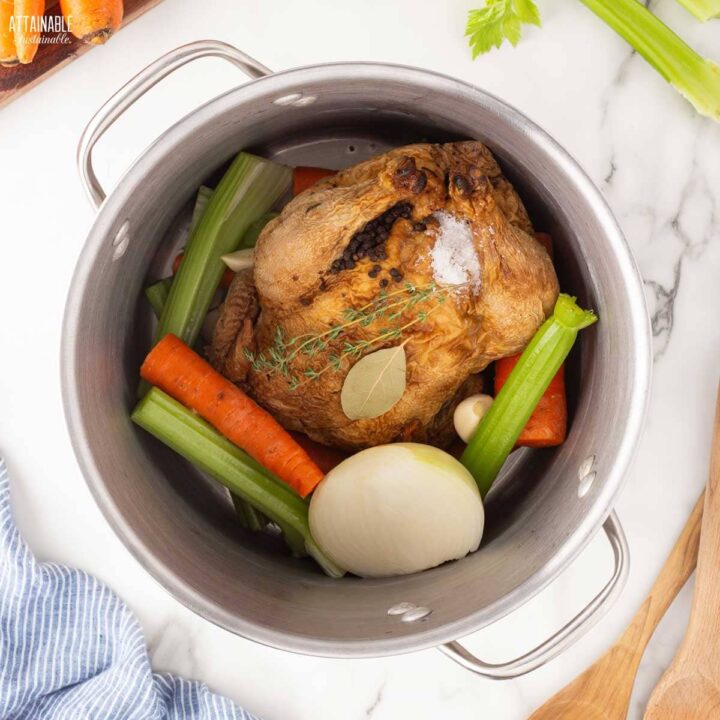
Easy Homemade Chicken Stock
This homemade chicken stock (or broth) is easy to make and is great for drinking or as a base for soups. Instead of spending money on canned broth, save some money and make your own. It's easy!
Ingredients
- 1 whole roasted chicken or 2-3 chicken carcasses
- 1 onion, halved
- 3 large carrots,
- 3 ribs celery
- 4 cloves garlic
- 1 bay leaf
- 2 sprigs fresh thyme
- 1 teaspoon peppercorns
- 1 teaspoon salt
- 2 tablespoons vinegar
Instructions
On the stove top:
- Place all of the ingredients in a large stock pot and add cold water to within 3″ of the top.
- Bring to a simmer, then turn the heat down to low. Keep the lid on the pot and cook for 6-8 hours.
In a slow cooker:
- Place all of the ingredients in the pot of your slow cooker and fill nearly to the rim.
- Turn the heat to low and cook for 24-48 hours.
In an Instant Pot:
- Place all of the ingredients in the Instant Pot liner. Add cold water to the maximum fill line.
- Lock the lid in place and cook on high pressure for 45 minutes.
- Allow the pressure to release naturally, then remove the lid.
Straining the broth:
- Once cooked, use a slotted spoon to remove the solids from the liquid.
- Pour the liquid through a fine mesh strainer to remove any remaining solids. Use this homemade stock immediately, refrigerate for up to 4 days, or freeze up to 6 months.
Notes
If you’ve cooked chicken with meat on the bones, set aside to cool, then use clean hands to remove the meat from the bones for use in other recipes.
Use fresh veggies, wilted veggies salvaged from your produce drawer, or use the trimmed ends of carrots, celery, and onions that you cut off when you’re cooking.
For shelf-stable broth: This chicken stock can safely be preserved using the pressure canning method outlined here. (You cannot safely preserve broth with a water bath canning method.)
For a low sodium chicken broth, skip the salt.
Nutrition Information:
Yield: 8 Serving Size: 1 cupAmount Per Serving: Calories: 6Unsaturated Fat: 0gSodium: 10mgCarbohydrates: 1g

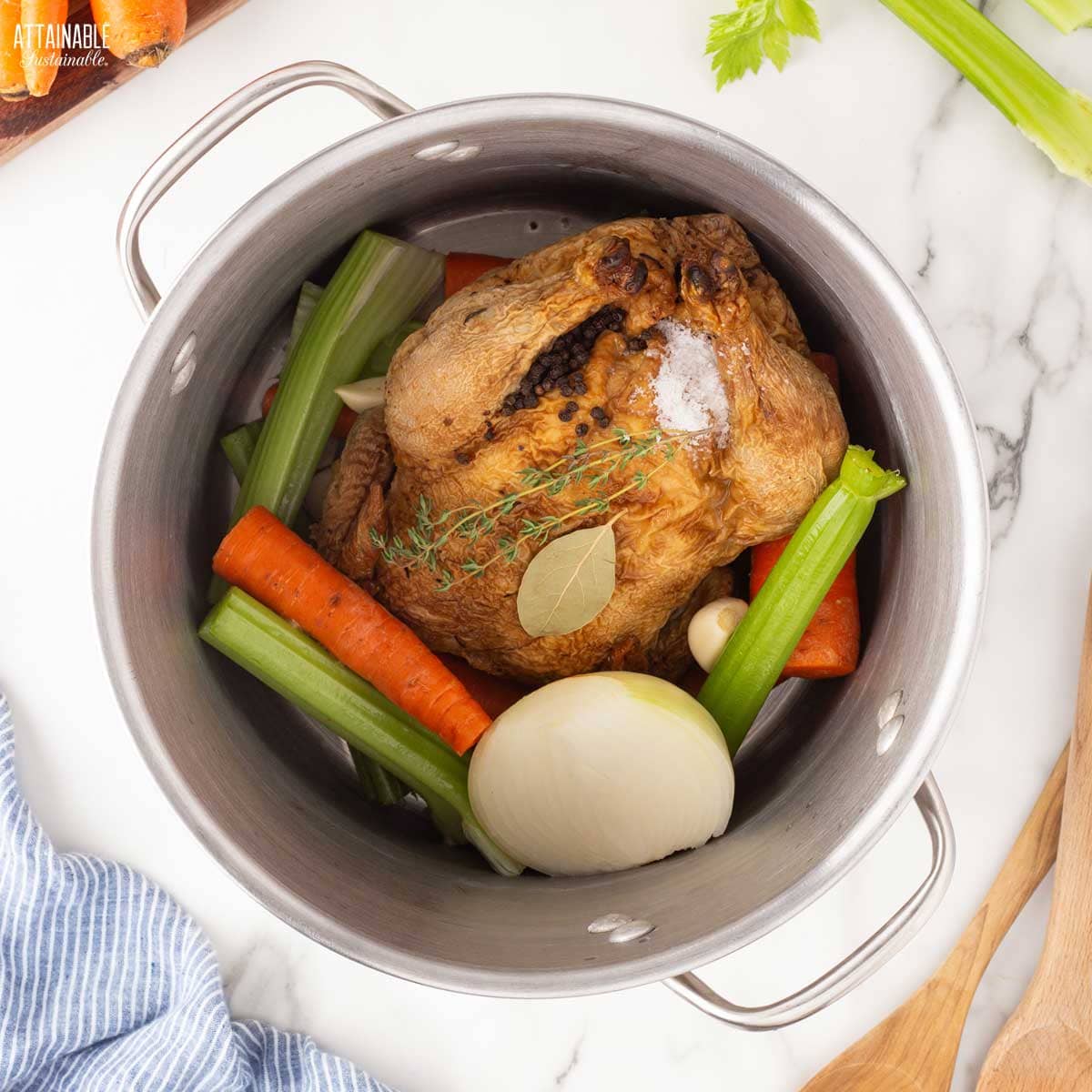
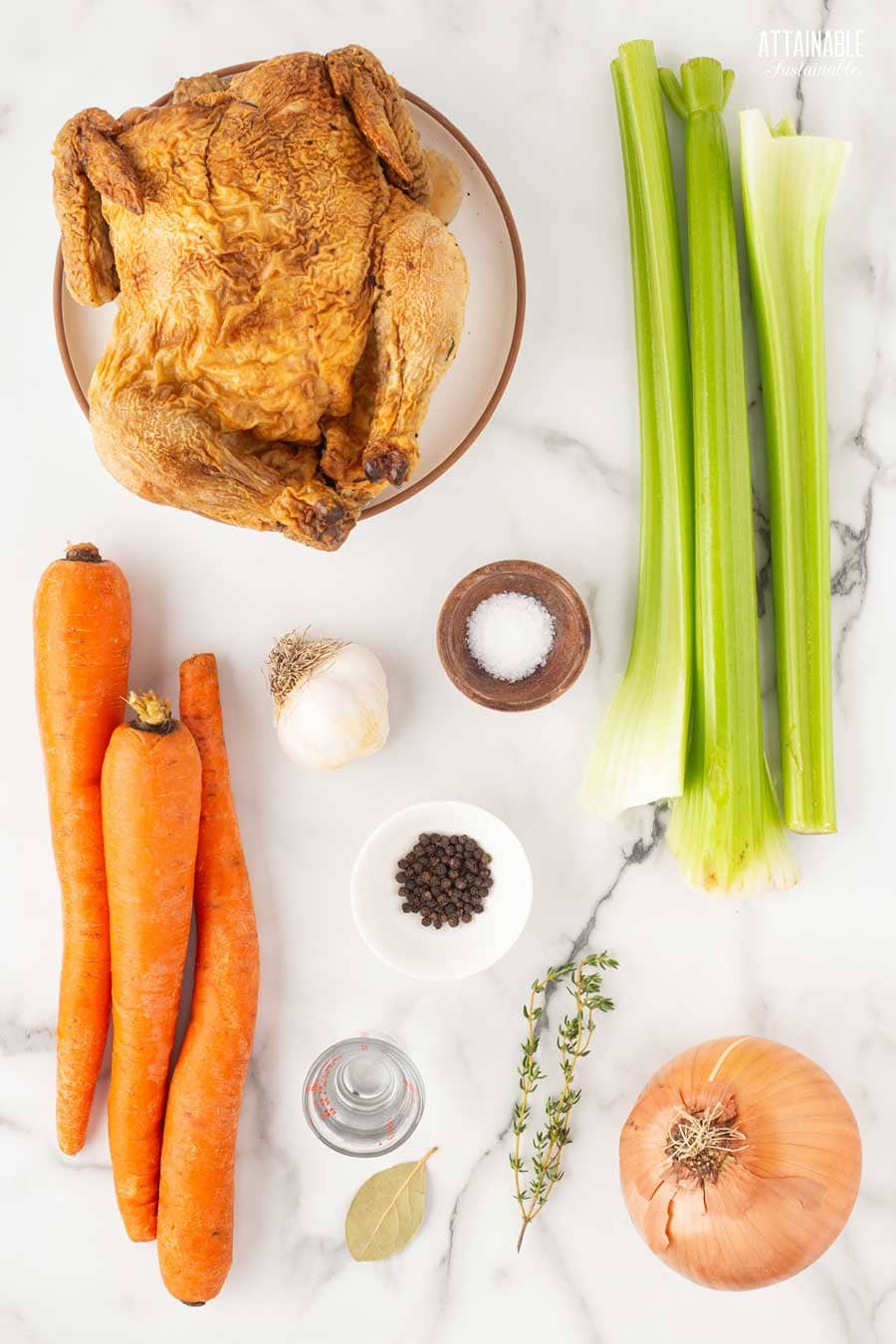
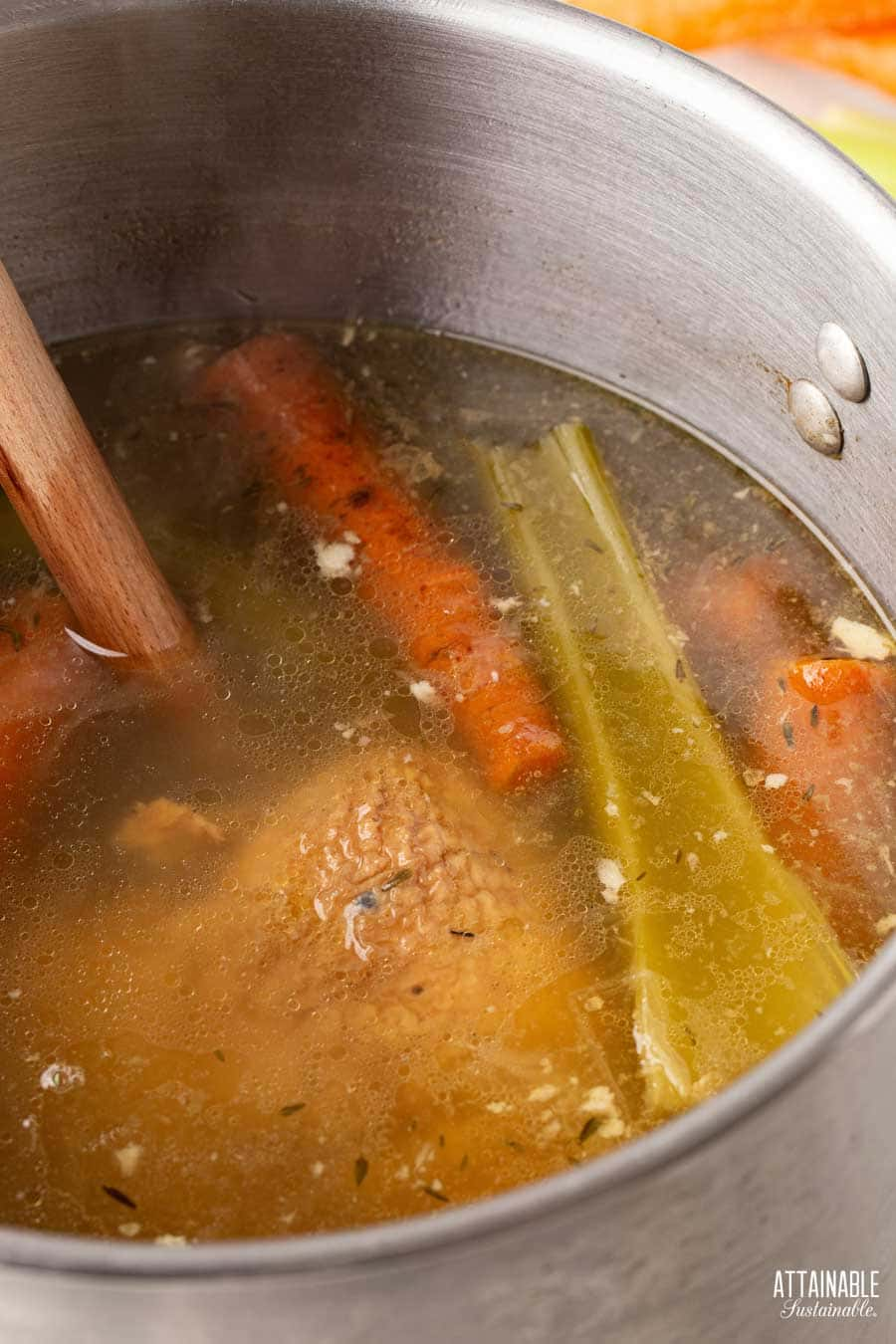

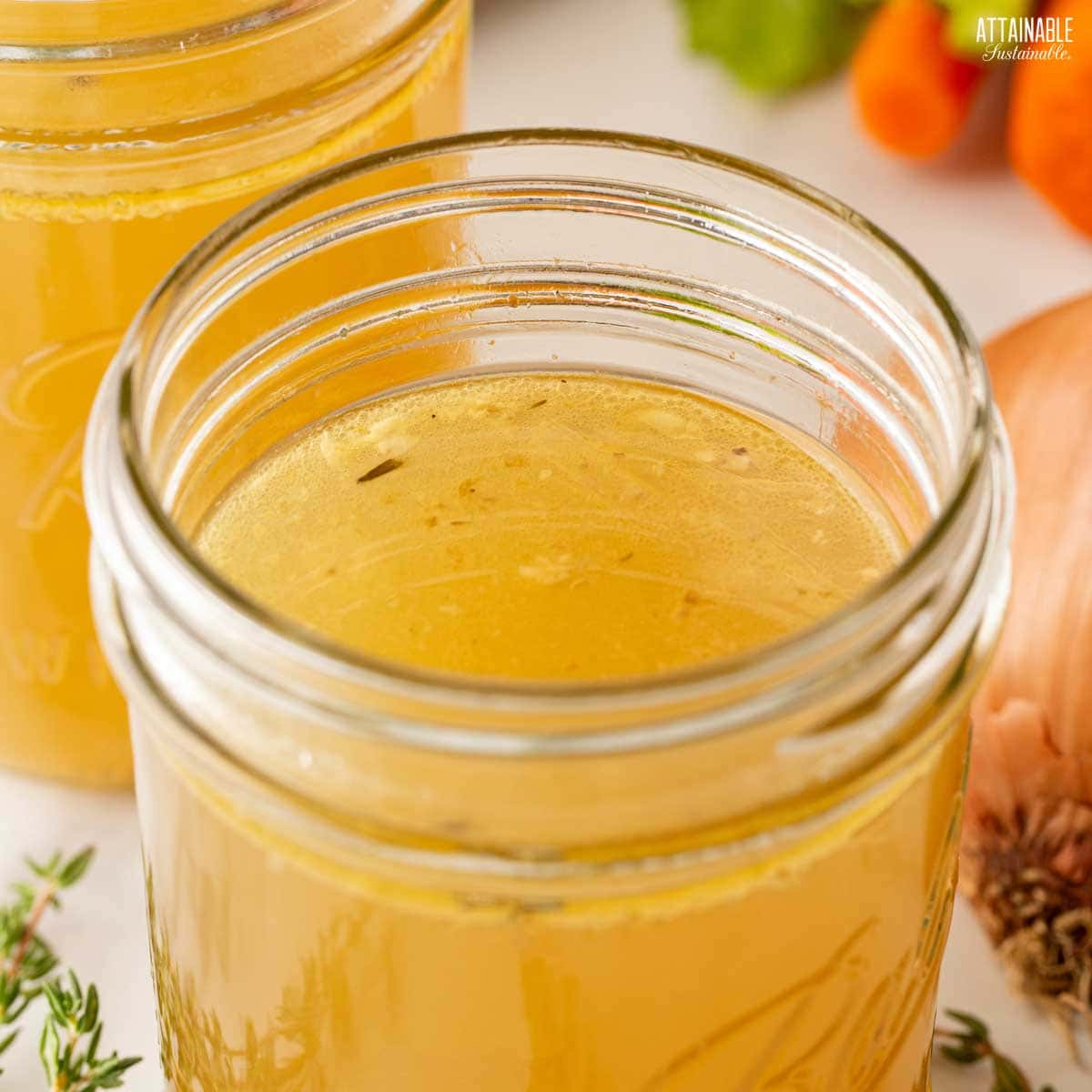
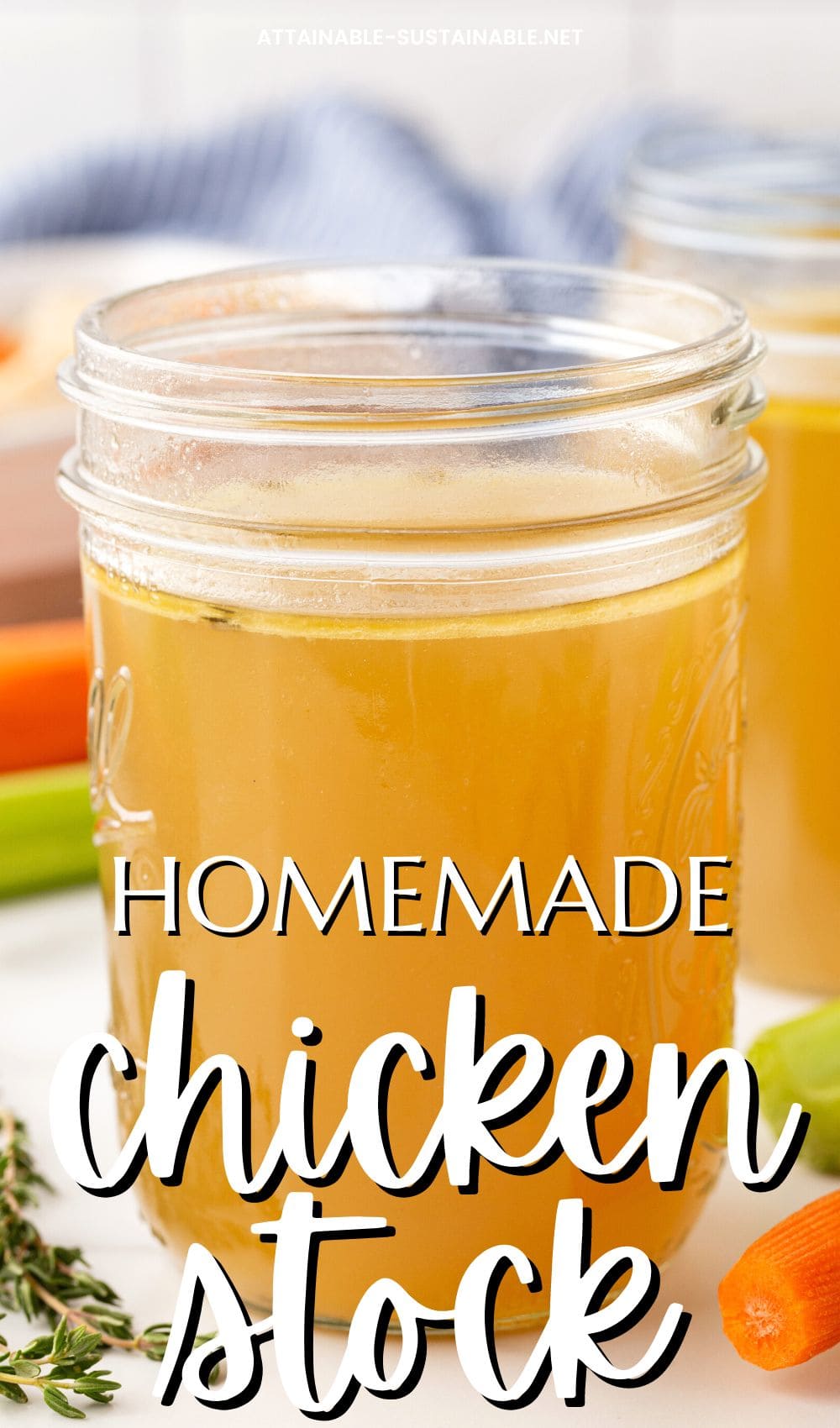

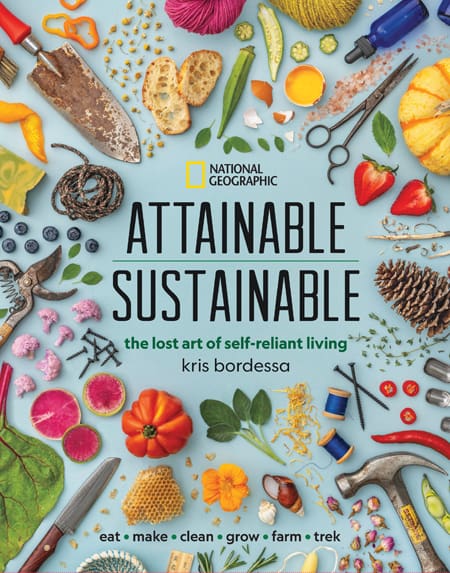
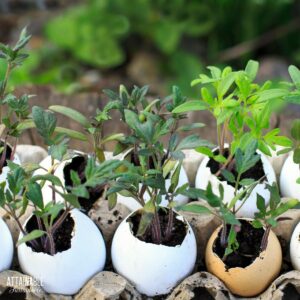
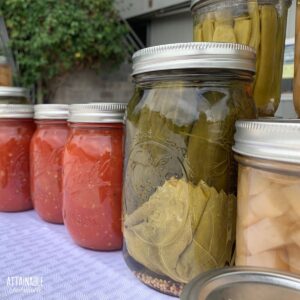
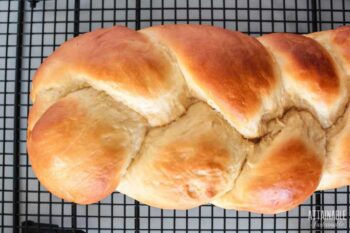
I,too,have been making and canning my own broth for years. After using homemade for so long store bought canned just doesn’t taste right! I keep bones (chicken, beef, pork) in the freezer until I have enough to make a large batch. I do the same with vegetable peelings to make a veg broth. Carrots, onions, garlic and tomato skins mostly since not all peelings are good for broth. So yummy and soooo easy.
Yes, so much better than store-bought!
About how much sodium (no salt) in this recipe?
Check the nutrition info at the bottom of the recipe!
So easy to make and a great result.
Where do you find the carcasses?
They’re left over from cooking a whole chicken/turkey.
Has anyone heard of roasting bones on sheet , low temp x2 hrs, then simmering with veggies and water??
My Mom did this w/ various red meat & pork bones.
She’d collect bones, freeze them, roast when she had a goodly amount.
Yes. Bones *absolutely make a better broth when roasted. I’ve done this.
When you can the broth, how long do you process it and at what pressure? And can I save the drippings from baking my turkey for later? Thanks
Editing my comment. It can be frozen OR you can use the instructions here to safely can it: https://www.attainable-sustainable.net/homemade-stock/
Can it be canned though?
The link is in the post, but I’ll put it here, too: https://www.attainable-sustainable.net/homemade-stock/
This I am going to do now. But, I have another question. Can I freeze the juice from baking the turkey for later? I don’t think it would be good to can because the fat in it would get rancid.
Nice post. I’d just like to add these two bits. Chicken feet make all the difference in chicken soup and chicken stock. Carcasses are great, but the depth of flavor and the increase in collagen makes the feet a really great addition if you can get them. Also, just a bit of acid (like lemon juice or apple cider vinegar) helps to leach collagen out of the bones. Just a Tablespoon will work!
It’s funny that you say this. I suggested this same thing and my son, who is really the most willing to try stuff like this, said, “I draw the line at chicken feet!” 😉 NEXT time, I think. 😉
Sorry for the silly question, but can you do this with other bones too, like beef or pork or lamb? Thanks.
Yes, you can. Roast the bones first for the best flavor.
Thank you Kris!
I do this all the time. I also, save all my veggie “scraps” when I am cooking. Put them in the freezer and when I have a good pile I make broth. I use every bit of the veggies I cook with. It’s great and I always have broth on hand.
I make mine the same way, but I cook it for about 12 hrs. This way the bones and cartilage break down and go into the broth. Super healthy!!
I make this and was with you all the way until you mentioned freezing. I never think to freeze it! What a good idea. But, remember not to freeze it in plastic.
A lot of times I’ll just turn around and make a delicious chicken soup, but I have a LOT of recipes that call for chicken broth, so I’ve been trying to keep my freezer stocked with homemade broth.
I will freeze it as “soup cubes” in an ice cube tray, and then transfer to a freezer bag. The soup cubes are typically 1oz per cube. You can use them as flavor boosters for things like rice or quinoa, or as a way to cool down soup for kids without diluting the flavor!
Another note, you can save chicken carcasses and veggie peelings in the freezer until you have enough to make stock and/or the inclination to do so. It doesn’t have to be a perfect storm of ingredients. Shove it all in the freezer, it’ll keep.
Yes! (Also, the perfect storm rarely happens in my kitchen.)
P.S. it makes your house smell FANTASTIC 🙂
also, if ppl haven’t done this before you don’t have to skin the onions or whatever. You’re going to strain all of that out. Just roughly chop and throw in there for flavour.
After the initial few hours, and straining, we take the lid off and reduce the stock for a bit. Makes it more concentrated. It takes up less space in freezer and you can then add water when you use it
Yes, I should have pointed out that not only do the onions not need to be peeled, vegetable trimmings can be used. Toss the ends of veggies like carrots, celery, parsnips in a freezer container and then toss them in when it’s time to make stock.
I’ve been making my own broth for a couple of years. I actually can most of mine. It is the easiest pressure canning project and great for beginners. I actually wrote posts about chicken, beef and vegetable broth on my blog and how to can it. What I don’t can I freeze. My favorite part is it makes my house smell like Christmas dinner. I freeze both turkey carcasses from thanksgiving and Christmas and do one huge batch in january. I also will stockpile chicken carcasses in the freezer until I have enough to do a batch big enough to can. Make sure the broth doesn’t boil while you are cooking the bones and your broth will stay clear.
Thanks for pointing out that this could be canned with a pressure canner, as well.
I REALLY want to encourage people to try this. I just started making homemade chicken broth this year, and I am amazed at how easy it is. Plus, it is practically free, which is a huge savings over the grocery store.
BTW, I only started doing it this year, because, believe it or not, I never thought about making it from scratch, because I honestly thought it was from scratch out of the can!
Isn’t it funny (well, funny and kind of sad) that even when we think we’re cooking from scratch, some of our ingredients are those of convenience? We’ve been so used to using these items for so long, they seem like they’re the “original” product. Happy to hear you’re doing it!
Love this post. I’m definitely going to try it. Also, I’d love to get your recipe for risotto. So far, I haven’t had much luck making a yummy risotto for my family.
Okay. Duly noted. I’ll see if I can get a risotto recipe up for you!
I often make straight veggie stock, using essentially this method. It adds such depth to dishes.